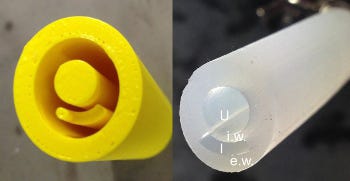Duke engineers shake up catheter biofilm research
One in five people admitted to a hospital in the United States requires a urinary catheter, the number-one cause of hospital-acquired infections. In fact, patients who rely on a plastic tube to eliminate their urine are practically guaranteed to develop an infection after just four weeks, caused by the formation of biofilms on the catheter wall. Duke University engineers have developed a urinary catheter design that can eliminate nearly all of the biofilm.
March 25, 2014
One in five people admitted to a hospital in the United States requires a urinary catheter, the number-one cause of hospital-acquired infections. In fact, patients who rely on a plastic tube to eliminate their urine are practically guaranteed to develop an infection after just four weeks, caused by the formation of biofilms on the catheter wall. Duke University engineers have developed a urinary catheter design that can eliminate nearly all of the biofilm. Instead of focusing on expensive antibacterial coatings, the researchers use physical deformation to knock the infectious film from its moorings.
Biofilms are formed by colonies of bacteria that are extremely difficult to kill. Once established, the biofilm becomes a host for other, more dangerous bacteria or begins to choke urine drainage, causing leakage or even patient trauma.
"A biofilm is like a city that protects and harbors harmful bacteria," says Vrad Levering, a PhD student in biomedical engineering at Duke, in a press release posted on the university website. "Our solution is like an earthquake that demolishes the infrastructure, leaving the rubble to be easily washed away by a flood of urine."
|
The yellow cast of a new catheter design created by a 3D printer is shown on the left along with the finished prototype on the right. The markings indicate the urinary duct (U), the flexible inner wall (i.w.) between the urinary duct and the inflation channel (I) and the stiff exterior wall (e.w.). Pressurizing the narrow chamber deforms the main channel, dislodging biofilm so that it can be flushed from the tube. |
To prevent the formation of biofilms, researchers traditionally have focused on developing antimicrobial treatments. However this technology is expensive and presents technical challenges. Moreover, many doctors fear that antimicrobial solutions may promote the evolution of antibiotic-resistant superbugs.
So Duke engineers decided to think outside of the cylinder.
"We ran experiments showing that if you stretch an elastic piece of rubber at a proper rate, you can pop various types of sticky biofilms right off of its surface," explains Xuanhe Zhao, professor of mechanical engineering and materials science, whose team partnered with that of Gabriel Lopez, professor of biomedical engineering.
"Those tests were initially aimed at cleaning submerged surfaces in marine environments, but the principle has many possible applications," continued Lopez. "So we thought, why not catheters?"
Their first model features a single channel that can be inflated with liquid or air running parallel to the main urinary tract. A thin, flexible barrier separates the two paths. Pushing liquid through the small inflation channel forces the thin wall into the urinary tract while leaving the outer dimensions of the catheter intact.
A prototype molded from a 3D-printed form worked beautifully, Levering says. The sudden deformation unseated more than 90% of the biofilm, which was washed away by a flow matching the slow movement of urine. Biofilm on the wall opposite the inflation channel was mostly unharmed, but the collaborative team has plans to produce a new prototype with inflation channels running along both sides of the main channel.
Lopez believes the demonstration is a clear proof-of-principle that their simple mechanical solution could revolutionize the catheter industry. Because the design would have low implementation costs, closely adheres to the dimensions of current catheters and would be easy for medical clinicians to operate, the team hopes to bring it to market and is currently searching for partners.
More than 30 million catheters are used each year, and that number is bound to grow in the coming decades on account of an aging population.
The concept has potential applications for a wide range of industries currently plagued by biofilms, such as dairy processing, petroleum transport, city drinking water, and heat exchangers, according to the researchers.
The study appeared online March 25 in Advanced Healthcare Materials.
The video embedded below shows how the catheter design works.
About the Author(s)
You May Also Like





